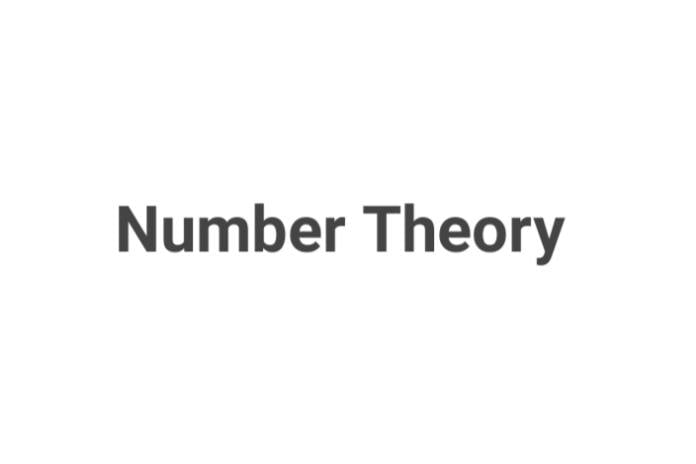Solve Number Theory Mcqs | Number Theory Mcqs with solution

Solve Number Theory Mcqs | Number Theory Mcqs with solution
1. For any positive integers a and b, there exists a positive integer n such that na > b is called:
A. Archimedean Property
B. Division Algorithm
C. Density Theorem
D. Fundamental Theorem of Arithmetic
2. Let S ⊆ N having the properties:
(i) 1 ∈ S and
(ii) Whenever k ∈ S, then k + 1 ∈ S, then
A. S = N
B. S ⊆ N
C. S ⊇ N
D. S 6= N
3. 2[1 + 2 + 3 + …. + n]=
A. n(n+1)/2
B. n(nn 1)/2
C. n(n + 1)
D. n(n – 1)
4. Given integers a and b with b 6= 0, there exist unique integers q and r satisfying
A. a = bq + r, 0 ≤ r < |b|
B. a = bq + r, 0 ≤ q < |b|
C. a = bq + r, 0 ≤ r < |a|
D. a = bq + r, 0 ≤ q < |a|
5. Which of the following is false?
A. a|a
B. If a|b and b|c, then a|c
C. If a|b and b|a, then a = b
D. If a|b then a|bc
6. If a|b and a|c, then for any x, y ∈ Z, we have
A. a|(bx + cy)
B. a|(bx x cy)
C. a|bc
D. All of these
7. If a|(b + c) and a|b, then
A. a|c
B. a – c
C. a|(b – c)
D. a – (b – c)
8. If a = 73 and b = 8, then
A. q = 9, r = =1
B. q = 9, r = 1
C. q = -9, r = 1
D. q = -9, r = -1
9. If a = 23 and b = 7, then
A. q = 4, r = 5
B. q = -4, r = 5
C. q = 4, r = -5
D. q = -4, r = -5
10. We read a|b as
A. a divides b
B. b is divisible by a
C. b is multiple of a
D. All of these
11. Let a, b ∈ Z with a ≠ 0. Then a|b if for some c ∈ Z,
A. a = bc
B. b = ac
C. c = a + b
D. c = ab
12. Any integer can be expressed in the form
A. 2n or 2n + 1
B. 3n, 3n + 1 or 3n + 2
C. 4n, 4n + 1, 4n + 2 or 4n + 3
D. All of these
13. For any n ∈ Z, 2.7^n + 3.5^n – 5 is divisible by
A. 24
B. 23
C. 9
D. 13
14. The product of any three consecutive integers is divisible by
A. 4
B. 5
C. 6
D. 7
15. Let a, b be nonzero integers. Then a positive integer d is called … of a and b if
(i) d|a and d|b
(ii) If c|a and c|b, then c ≤ d.
A. G. C. D
B. L. C. M
C. H. C. F
D. Both A and C
[We denote G. C. D. of a and b as (a, b) or gcd(a, b).]16. Let a, b be nonzero integers and (a, b) = 1, then a, b are called
A. Prime to each other
B. Coprime
C. Relatively prime
D. All of these
17. The G.C.D of two non zero integers a and b:
A. Is always unique
B. Is not necessarily unique
C. Always exists
D. Both A and C
18. If a|b, then (a, b)=
A. a
B. b
C. |a|
D. |b|
19. (8, -40)=
A. 8
B. -8
C. 2
D. -2
20. If d = (a, b), then there exist x, y ∈ Z such that:
A. d = ax + by
B. d = ax x by
C. d = ay + bx
D. All of these
21. Let k ∈ Z and a, b ∈ Z − {0}
A. k(a, b)
B. |k|(a, b)
C. Both A and B
D. None of these
22. If d = (a, b), then
A. ( a/d,b/d) = 1
B. ( a/d,b/d) = d
C. ( a/b,b/a) = d
D. ( a/b,b/a) = 1
23. If a|bc and (a, b) = 1, then
A. a|c
B. b|c
C. a – c
D. a|(b + c)
24. Let a, b ∈ Z − {0}. Then a positive integer m is called … of a and b if
(i) a|m and b|m
(ii) If a|n and b|n then m ≤ n.
A. G. C. D
B. L. C. M
C. H. C. F
D. Both B and C
[We denote L. C. M of a and b as < a, b >, [a, b] or lcm(a, b).]25. For any non zero integers a, b we have
A. < a, b >= ab(a, b)
B. (a, b) = ab < a, b >
C. a(a, b) = b < a, b >
D. < a, b > (a, b) = ab
